|
G.E.M. Skues and the hatching BWO puzzle
By Goran Grubic and Aleksandar Panic
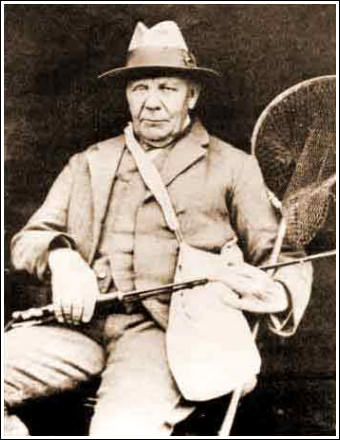
G.E.M. Skues is our favourite
fly fishing author for many reasons. The most important reason
is that his texts are still interesting to read although some
were written about hundred years ago. He was one of the
“founding fathers” of modern fly fishing, and it is amusing to
discover in his texts ideas which created whole trends in fly
fishing as we know it today. One of the main things remembered
about Skues is that he was “the father” of nymph fishing. If we
consider how important and diverse nymph fishing became, it is
quite appealing to read his own descriptions of how he slowly
evolved his techniques and laid a foundation for the ways we
fish today.
During his long life
Skues spent considerable time on the “way of a trout with a
fly”, but also thinking and writing about fly fishing. All of
his books, aside from the last one, were actually collections of
his articles published in The Field, Journal of The Flyfisher’s
Club and other magazines. He had enough time and space not only
to explain how to fish with his flies and methods, but also to
describe how he developed them. Some of his solutions are as
good today as they were in his time, and we use them quite often
on various rivers. However, he was not able to solve everything,
as no one is. One of the things that remained to be solved was
what we can call “the hatching BWO puzzle”.
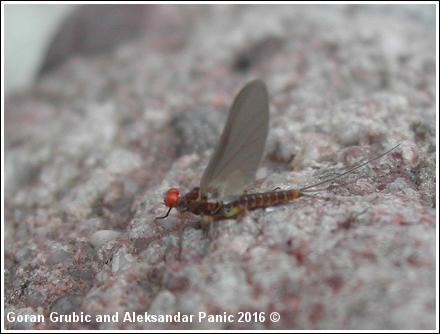
Blue-Winged Olive,
male Dun
Blue-Winged Olive (BWO)
is a fly fisherman’s name for Serratella ignita (formerly
Ephemerella ignita), which is very important for trout fishing,
not only on the Itchen which used to be Skues’ favourite chalk
stream, but also on most rivers throughout Europe. Very often
the flies supposed to imitate BWO fail in seducing trout or
grayling. Skues created or used several flies to imitate the
BWO, but he was never sure in their effectiveness, and he wrote
with caution about them. Courtney Williams (A
Dictionary of Trout Flies)
wrote that “Mr. Skues has obviously paid a good deal of
attention to copying the BWO and has provided several attractive
ties. Fishing on the Itchen as he did for so many years, he had
exceptional opportunities for testing them”. However,
“Unfortunately for the fly fisher the BWO is one of the most
difficult insects to copy successfully.”
Skues created three
nymph imitations for the BWO (Nymph
Fishing for Chalk Stream Trout)
and wrote about them: “I had occasionally had trout on an actual
imitation”. Also “Then (though I never been able even to
surmise) a pattern dressed thus will sometimes be taken
greedily”. But, as you can see, he was honest enough to be
reserved about those flies.
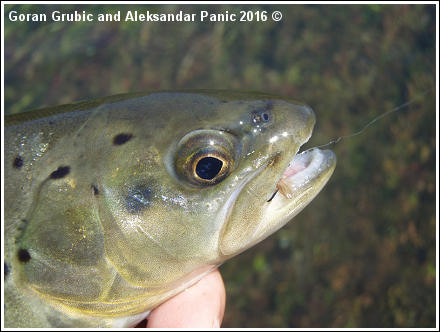
Trout on No-hackle BWO
Skues was quite successful when
there was a spinner fall of Sherry Spinners, which is the name
for BWO in its final dress. He recommended (The
Way of a Trout With a Fly)
two dry flies for such occasions: Pheasant’s Tail (“when deep
ruddy brown Sherry Spinner is plentiful”), and Rusty Spinner
(“excellent representation of the male spinner of the BWO also
called Sherry Spinner”). We caught a lot of trout using those
flies in such circumstances, and can tell that these
recommendations are still excellent. However, when it comes to
duns, there was no consistent solution. For BWO subimago Skues
recommended (The
Way of a Trout With a Fly)
Orange Quill and “another pattern which occasionally kills well
is dressed in the same way except that the body is of heron herl
dyed greenish-yellow olive”. He wrote about BWO emergences that:
“From mid-June to the end of the season there is scarcely an
evening rise when it may not put in an appearance. When it does
put in an appearance there is always a chance of a big fish.
When puts in an appearance in quantity there is a chance of a
big basket, and all of the fish in the basket big”. But “It may
be asked why the Orange Quill is taken at night for the BWO. I
answer frankly, I don’t know.” Latter (The
Blue-Winged Olive and the Welshman’s Button (Side-Lines,
Side-Lights & Reflection))
he also wrote: “Mr. H.S. Hall writes under his description of
his description of his dressing of the BWO, in his charming
paper on the dry fly in the ‘Fishing Volume of Badminton
(1885),’ that ‘no satisfactory pattern has yet been dressed’.
And that observation remains true to this day. It is no doubt
the fact that has been discovered that when BWO is hatching out
of an evening and the duns are being taken on the surface, the
Orange Quill is often enthusiastically accepted, and that there
are one to two other patterns which are at times taken almost
equally greedily; but still the angler is at times faced with
utter defeat on evenings when the trout seem to be mad on the
BWO, its nymph or its male or female spinner, and all these
patterns fail him.”
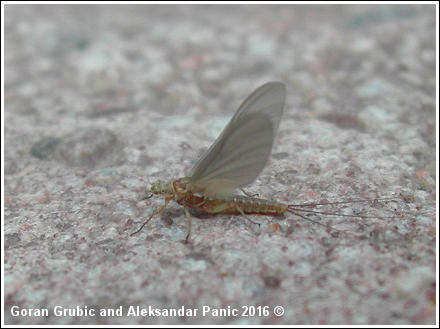
Blue-Winged Olive,
female Dun
As a conclusion he wrote
(The Way of a Trout With a Fly) that: “The BWO is seldom
taken on the surface during the daytime, and when it is its
artificial imitation is still less frequently accepted, but I
have had excellent sport with well sunken nymph”. Latter he
discovered a fly called McCaskie’s Green Cat, and wrote: “when
in the day time the trout are taking BWO nymphs (and they never,
or almost never, take the BWO sub-imago form during the day) a
fly dressed on a No. 1 hook with pale orange silk dubbed lightly
and loosely with McCaskie’s Green Cat (McCaskie
Green Cat (Side-Lines, Side-Lights & Reflection))
and hackled lightly with soft dark blue henny hackle and
glycerined to sink properly is really very effective, even in
the hands of an angler who has a prejudice in favour of thinking
he knows why he uses any particular pattern rather than
another”.
As we can see, Skues had
no solution for trout feeding on the surface during the BWO
hatch, and he had to use sunk fly (or what we today call
“emerger”) to catch them. Obviously some other sort of fly was
needed for such situations, and it took some time and effort to
attain the correct solution. Even today fishing BWO emergences
can be complicated and frustrating, but there are flies which
can catch even the toughest trout. Interestingly, the best
solutions that we know for that problem came from Bosnia, which
is a place known and visited by Skues (Turco
as a Fly Fisher (Side-Lines, Side-Lights & Reflection)).
He wrote (Speculations
on the Origins of Fly Fishing (Side-Lines, Side-Lights &
Reflection)): “I paid a
holiday visit to Bosnia with a friend in September 1897, and
spent some sixteen days in wild parts of that lovely and
romantic looking country.”

Trout on BWO
Emerger
In his brilliant history
of fly fishing Herd (The
Fly) wrote that it is
likely that Skues got an idea to use wet flies on chalk streams
in Bosnia, although about that Skues (Nymph
Fishing for Chalk Stream Trout)
wrote: “I am omitting reference to other rivers, including
Norwegian and Bosnian streams, which had little or no bearing on
my progress towards nymph fishing in chalk streams”. As a lawyer
he was very precise with his words, so we believe that this
statement is true. However, we are positive that this Bosnian
visit helped him in his experiments with wet flies on chalk
streams (the Itchen actually), which eventually led to his
development of nymph fishing.
If we examine his
progress with wet flies, we can see that in 1892 Skues had the
“first experience of the efficiency of the wet fly on the Itchen
(Minor Tactics of the
Chalk Stream).” The
second experience came 2-3 years later, and then several years
after that, and his experiences with the wet fly on a German
stream he realized its potentials. He explained: “I began to
experiment on the bulgers with small double hooked Greenwell’s
Glories as Mr. Ewan M. Tod recommended for his Scotch rivers (Minor
Tactics of the Chalk Stream).”
Than in 1897 came his Bosnian trip where Skues had witnessed the
efficiency of fishing wet flies with a short fixed line. That
was clear confirmation that catching grayling and trout while
feeding on small ephemerides in “gin clear” rivers is not only
possible but very successful. All this led to his further
experiments with wet flies which he described in a series of
articles that were subsequently gathered in a book (Minor
Tactics of the Chalk Stream).

Skues' flies from
Minor Tactics
(Click image for larger
version)
In chapter IV of Minor
tactics of the chalk stream “On wet fly dressings for chalk
streams” Skues lists Greenwell’s Glory tied with blackbird and
starling wings. All of the flies listed had wings but there is
no doubt that Skues wanted to imitate nymphs with them, since he
wrote: “It will be observed that hooks are a size larger than
those employed for floaters can often be used. Nymphs are
slightly larger than their duns.” Greenwell’s Glory is quite
famous and its history well documented, but it is strikingly
similar to a traditional fly used in Bosnia with the name Kreja
(Jay). It is common for traditional flies to have names given
according to the bird which provided feather for the dressing
(like Orange Partridge and similar). The name Kreja referred to
the pale dun wings made from jay’s primary wing feathers. The
fly itself has several variations, with bodies made of silk,
hemp and stripped quills, mainly in some shade between olive,
yellow and brown, and it was often used when BWO was hatching.
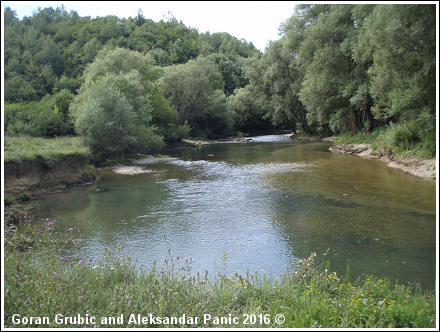
The Sanica river
It is interesting to
note that locals with their crude “pre-Waltonian” tackle caught
more grayling than Skues with his “post-Halfordian equipment” (Turco
as a Fly Fisher (Side-Lines, Side-Lights & Reflection)).
About their fishing methods he wrote: “I found the natives on
several different rivers, divided by stiff mountain ranges,
pursuing the sport of fly fishing with gear of identical
character (like those mentioned by Aelian). I judged from the
identity of method in use in different valleys that the method
was probably traditional, and it seemed to me to be quite a
possibility that it might have come down with little variation
from that described by Aelian above mentioned as been practiced
by Macedonians in his day – the second and third centuries A.D.
– and it may have been much older (Speculations
on the Origins of Fly Fishing (Side-Lines, Side-Lights &
Reflection)).”
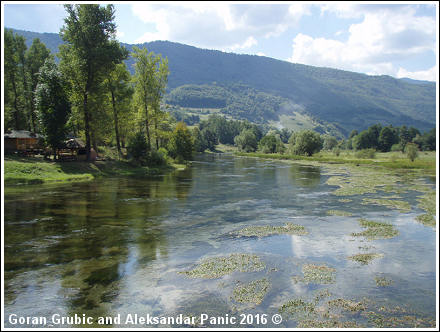
The Pliva river
The rivers Skues visited
were The Pliva and The Sana with their “dazzling blue waters”,
and they are as beautiful today as they were in his time, in
spite of all the troubles that that country has seen in the
meantime. The Pliva and the Sana with its tributaries (the
Ribnik and the Sanica), are among the most beautiful rivers in
Europe and with good keeping the fishing is probably better
today than it was in Skues’ times. What is more, those rivers
are what we call “The BWO Academy” because it is hard to find a
place where hatches of that insect are so dense and last so
long. As a matter of fact, there is five recorded species of BWO
on the Balkans, members of Ephemerella family (Serratella
ignita, Serratella maculocaudata, Serratella spinosa,
Ephemerella mucronata, Torleya mayor), which look almost
identical and live in the same rivers with variation only in
their size (from #14 to #24). They are hatching almost every day
during the summer and autumn. In effect such rivers are giving
more than average conditions for experimenting with flies. So it
is not surprising that there were numerous great fly tiers and
fly fishermen in Bosnia, in the past and today. Using modern
knowledge and materials they created flies that can catch trout
or grayling during the daytime hatch of BWO. The flies are
emergers, intended to be fished with their bodies sunk into the
surface film, and the material for their wings are CDC (Cul de
Canard) feathers.

The Sana river
CDC is not exactly a new
material, as it was used by Swiss fly tiers Maximilien Joset in
Courtfaivre and Charles Bickel in Valorbe in Jura region since
the 1920s. Skues was alive in those times, but was not aware
that those gentlemen are starting the “CDC revolution”. In the
first flies the CDC feathers were used as hackle, turned around
the hook shank. Than in 1983 Marjan Fratnik from Slovenia
discovered a new way to use these feathers, as wings. His simple
F-fly was a great achievement, and its offspring are many dozens
of new patterns, mostly emergers used to catch fish when they
are most selective. The Bosnian BWO imitations are in that
category. There are many variations of those flies tied by
locals, but actually all that can be reduced to two patterns.
One is a grandchild of the already mentioned Kreja, called
Krejica, which is just a diminutive, meaning “small jay”, and
interestingly it is tied without any jay feathers. It is just a
bit more complex than F-Fly, with hackle tails, thread body and
CDC wing. The other one is called The Emerger, and it is really
a variation of a British fly called Shuttlecock. Of course,
there are hundreds of various emerger patterns, but in Bosnia
only this fly is called The Emerger, and not without reason,
because it is very effective.

The Ribnik river
On the presented
pictures we are showing those patterns in the color which was
most successful for us, but in Bosnia they tie the bodies from
pale yellow, to olive and brown, while wings are normally of
natural CDC ranging from very pale gray to almost black. If you
prepare those flies in sizes from 16 to 20 (with some 22 and
24), you will be ready to tackle the most finicky grayling or
trout you can find eating on the surface. Those flies are very
reliable and if trout taking BWO pass up those two patterns, the
angler can be almost sure that his presentation is at fault (to
paraphrase the Datus Proper’s words (What the Trout Said)).
Recommended flies for hatching
BWO (our versions of Bosnian standards):
CDC No-hackle BWO (The
Krejica)
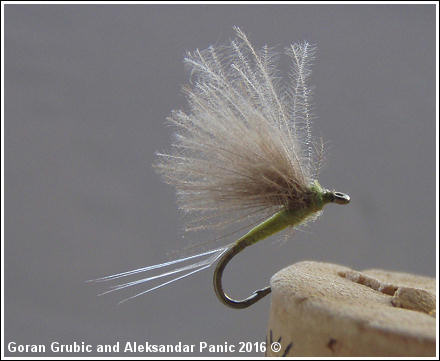
Hook: TMC 100 or any
other light dry fly model (size 22 is on the photo)
Thread: UNI Light Olive 8/0, on smaller hooks Veevus
12/0, 14/0 or 16/0 in Light Olive is excellent
Tail: Metz natural medium blue dun hackle fibers
Abdomen: tying thread
Thorax: Pale Evening Dun Super Fine Dubbing
Wings: two CDC tips or clump of CDC barbs in natural grey
or khaki
The tying is basically same (with the added dubbing for thorax)
as described in the following article:
http://www.rackelhanen.se/eng/10442.htm
CDC BWO Shuttlecock (The
Emerger)
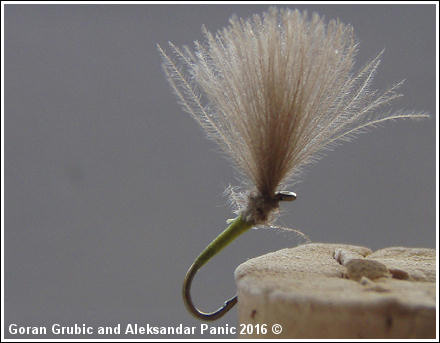
Hook: TMC 100, TMC 2487
or any other light fly model (size 22 is on the photo)
Thread: Light Olive, UNI 8/0 or Veevus 12/0, 14/0, 16/0
Abdomen: tying thread
Thorax: CDC dubbing in natural grey or khaki, or Tan Super Fine
Dubbing
Wings: two CDC tips in natural grey or khaki
Fishing
recommendations:
Use a long leader (at least 5
m.) with a fine tippet (0.10 mm). Use medium fast or slow rod to
protect the fine tippet. Try to avoid drag at all costs using
whichever casting and mending technique is needed. Use fly one
size smaller than the naturals you see on the water (they appear
larger in the air). If the fish refuse a fly after several
correct presentations than change to one size smaller fly. Fill
your box with ample amounts of those two flies (we have a dozen
of each size from 16 to 22). Don’t waste time on drying CDC
flies, let the fly dry on a “fly patch” and replace it with a
dry one. Barbless hooks are not only better for releasing fish,
flies tied on them also last longer.
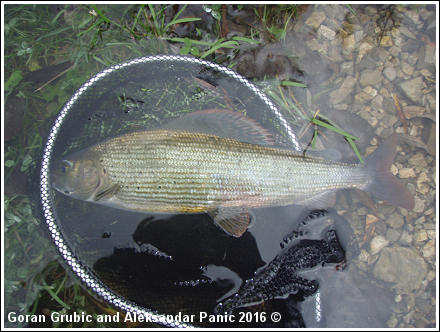
Grayling on BWO
fly
More details about the BWO-s
and their imitations is given in the following article:
http://globalflyfisher.com/fish-better-patterns/euro-bwos
By Goran Grubic
and Aleksandar Panic 2016 ©
www.flyandtrout.com

|